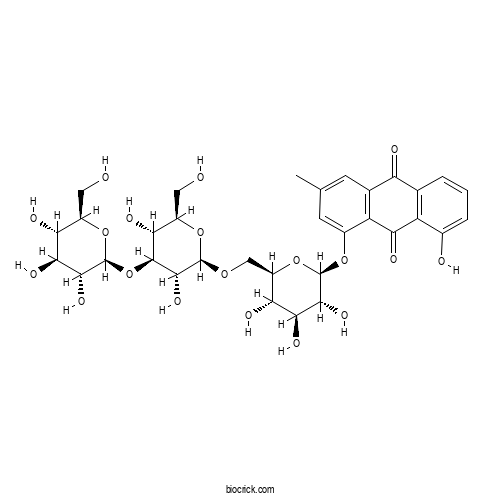Chrysophanol triglucosideCAS# 120181-07-9 |

Quality Control & MSDS
3D structure
Package In Stock
Number of papers citing our products

| Cas No. | 120181-07-9 | SDF | Download SDF |
| PubChem ID | 5317697.0 | Appearance | Powder |
| Formula | C33H40O19 | M.Wt | 740.66 |
| Type of Compound | N/A | Storage | Desiccate at -20°C |
| Solubility | Soluble in Chloroform,Dichloromethane,Ethyl Acetate,DMSO,Acetone,etc. | ||
| Chemical Name | 1-[(2S,3R,4S,5S,6R)-6-[[(2R,3R,4S,5R,6R)-3,5-dihydroxy-6-(hydroxymethyl)-4-[(2S,3R,4S,5S,6R)-3,4,5-trihydroxy-6-(hydroxymethyl)oxan-2-yl]oxyoxan-2-yl]oxymethyl]-3,4,5-trihydroxyoxan-2-yl]oxy-8-hydroxy-3-methylanthracene-9,10-dione | ||
| SMILES | CC1=CC2=C(C(=C1)OC3C(C(C(C(O3)COC4C(C(C(C(O4)CO)O)OC5C(C(C(C(O5)CO)O)O)O)O)O)O)O)C(=O)C6=C(C2=O)C=CC=C6O | ||
| Standard InChIKey | SOWISUOFXLRAML-VULFOYAMSA-N | ||
| Standard InChI | InChI=1S/C33H40O19/c1-10-5-12-19(24(41)18-11(20(12)37)3-2-4-13(18)36)14(6-10)48-32-27(44)26(43)22(39)17(51-32)9-47-31-29(46)30(23(40)16(8-35)49-31)52-33-28(45)25(42)21(38)15(7-34)50-33/h2-6,15-17,21-23,25-36,38-40,42-46H,7-9H2,1H3/t15-,16-,17-,21-,22-,23-,25+,26+,27-,28-,29-,30+,31-,32-,33+/m1/s1 | ||
| General tips | For obtaining a higher solubility , please warm the tube at 37 ℃ and shake it in the ultrasonic bath for a while.Stock solution can be stored below -20℃ for several months. We recommend that you prepare and use the solution on the same day. However, if the test schedule requires, the stock solutions can be prepared in advance, and the stock solution must be sealed and stored below -20℃. In general, the stock solution can be kept for several months. Before use, we recommend that you leave the vial at room temperature for at least an hour before opening it. |
||
| About Packaging | 1. The packaging of the product may be reversed during transportation, cause the high purity compounds to adhere to the neck or cap of the vial.Take the vail out of its packaging and shake gently until the compounds fall to the bottom of the vial. 2. For liquid products, please centrifuge at 500xg to gather the liquid to the bottom of the vial. 3. Try to avoid loss or contamination during the experiment. |
||
| Shipping Condition | Packaging according to customer requirements(5mg, 10mg, 20mg and more). Ship via FedEx, DHL, UPS, EMS or other couriers with RT, or blue ice upon request. | ||

Chrysophanol triglucoside Dilution Calculator

Chrysophanol triglucoside Molarity Calculator
| 1 mg | 5 mg | 10 mg | 20 mg | 25 mg | |
| 1 mM | 1.3501 mL | 6.7507 mL | 13.5015 mL | 27.0029 mL | 33.7537 mL |
| 5 mM | 0.27 mL | 1.3501 mL | 2.7003 mL | 5.4006 mL | 6.7507 mL |
| 10 mM | 0.135 mL | 0.6751 mL | 1.3501 mL | 2.7003 mL | 3.3754 mL |
| 50 mM | 0.027 mL | 0.135 mL | 0.27 mL | 0.5401 mL | 0.6751 mL |
| 100 mM | 0.0135 mL | 0.0675 mL | 0.135 mL | 0.27 mL | 0.3375 mL |
| * Note: If you are in the process of experiment, it's necessary to make the dilution ratios of the samples. The dilution data above is only for reference. Normally, it's can get a better solubility within lower of Concentrations. | |||||

Calcutta University

University of Minnesota

University of Maryland School of Medicine

University of Illinois at Chicago

The Ohio State University

University of Zurich

Harvard University

Colorado State University

Auburn University

Yale University

Worcester Polytechnic Institute

Washington State University

Stanford University

University of Leipzig

Universidade da Beira Interior

The Institute of Cancer Research

Heidelberg University

University of Amsterdam

University of Auckland

TsingHua University

The University of Michigan

Miami University

DRURY University

Jilin University

Fudan University

Wuhan University

Sun Yat-sen University

Universite de Paris

Deemed University

Auckland University

The University of Tokyo

Korea University
- Chrysophanol-1-O-β-gentiobioside
Catalog No.:BCX1536
CAS No.:54944-38-6
- Isobutyryl alkannin
Catalog No.:BCX1535
CAS No.:87562-78-5
- Ansamitocin P3
Catalog No.:BCX1534
CAS No.:66584-72-3
- Mexoticin
Catalog No.:BCX1533
CAS No.:18196-00-4
- 31-Norlanostenol
Catalog No.:BCX1532
CAS No.:16910-39-7
- (+)-Dehydroabietic acid
Catalog No.:BCX1531
CAS No.:1231-75-0
- d-Epigalbacin
Catalog No.:BCX1530
CAS No.:84709-25-1
- 4-Vinylphenol
Catalog No.:BCX1529
CAS No.:2628-17-3
- Dihydroactindiolide
Catalog No.:BCX1528
CAS No.:15356-74-8
- Isoescin Ie
Catalog No.:BCX1527
CAS No.:1613506-28-7
- (±)-Dihydrokaempferol
Catalog No.:BCX1526
CAS No.:104486-98-8
- Bitalgenin
Catalog No.:BCX1525
CAS No.:2192-25-8
- 11-epi-morgroside V
Catalog No.:BCX1538
CAS No.:2146088-12-0
- β-Chamigrenic acid
Catalog No.:BCX1539
CAS No.:1174388-31-8
- Epigalantamine
Catalog No.:BCX1540
CAS No.:1668-85-5
- N-Desmethyl Galanthamine
Catalog No.:BCX1541
CAS No.:41303-74-6
- Anemarrhenasaponin Ia
Catalog No.:BCX1542
CAS No.:221317-02-8
- Momordin IIc
Catalog No.:BCX1543
CAS No.:96990-19-1
- Oleanolic acid -3-O-glucosyl(1-2)xylyl(1-3)glucosiduronic acid
Catalog No.:BCX1544
CAS No.:1447508-78-2
- 7α-Hydroxycholesterol
Catalog No.:BCX1545
CAS No.:566-26-7
- 8-Methyl Chrysophanol
Catalog No.:BCX1546
CAS No.:3300-25-2
- Ursonic acid methyl ester
Catalog No.:BCX1547
CAS No.:989-72-0
- Rotundifuran
Catalog No.:BCX1548
CAS No.:50656-65-0
- Lactiflorin
Catalog No.:BCX1549
CAS No.:1361049-59-3
Inhibitory activities of Cassia tora and its anthraquinone constituents on angiotensin-converting enzyme.[Pubmed:18803227]
Phytother Res. 2009 Feb;23(2):178-84.
As a component of our program that pertains to the isolation of antihypertensive agents derived from natural products, we screened the bioactivity of seeds from raw and roasted Cassia tora via angiotensin converting enzyme (ACE) inhibitory assays. We found that both of the MeOH extracts from the raw and roasted C. tora exhibited significant inhibitory properties against ACE, demonstrating more than 50% inhibition at a concentration of 163.93 microg/mL. Emodin (3), alaternin (4), gluco-obtusifolin (5), cassiaside (6), gluco-aurantioobtusin (7), cassitoroside (8), toralactone gentiobioside (9), and Chrysophanol triglucoside (10) had been previously isolated; however, questin (1) and 2-hydroxyemodin 1-methylether (2) were isolated from C. tora for the first time in this study. Among them, only anthraquinone glycoside (7) demonstrated marked inhibitory activity against ACE, with an IC(50) value of 30.24 +/- 0.20 microM. Conversely, aurantioobtusin (7a), obtained from the acid hydrolysis of 7, showed no activity. Further inhibitory kinetics analyzed from Lineweaver-Burk plots showed 7 to be a competitive inhibitor with a Ki value of 8.3 x 10(-5) M. Moreover, compound 7 showed marked inhibitory and scavenging activities with an IC(50) value of 49.64 +/- 0.37 microM (positive control; trolox: 26.07 +/- 1.05 microM) for total reactive oxygen species generation, and 4.60 +/- 1.12 microM (positive control; penicillamine: 0.24 +/- 0.04 microM) for ONOO(-).


